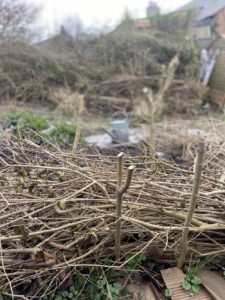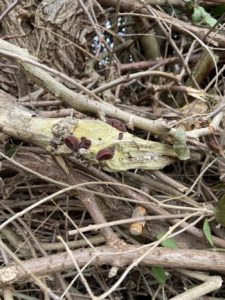Alys Fowler embarks on a new column as she starts from scratch in a new garden. This month, there is beautiful potential to be found in the brash.

My garden is a mess. It is littered with twigs and branches; there are limbs that need sawing and splitting for the wood pile and everywhere there are piles upon piles of brush. All of this to try and tame a privet hedge.
My neighbour is very fond of this hedge, it’s what he calls his own private Hampton Court. A generous description for this wild tangle that waves about madly in the winds. He wants it left tall and I don’t. I understand his desire for privacy, so I promise I’ll leave his side longer.
My solution is odd. I’ve attempted to cloud prune the front half and the rest that backs his property I’ve hedge-laid — but not in a typical manner because that reduces his half too much, so instead I’ve hedge-laid the top. In essence that meant I just folded the top half over. Then because I want to end all talk of his hedge, I’ve backfilled the gaping bottom with all the brush I’d produced in chopping it down and planted several clematis and roses to embroider the holes. Thus, filling any opportunity for my neighbour to catch my eye through these gaps and tell me I’ve ruined Hampton Court.

It looks completely deranged and I can’t say it looks pretty just yet. But what a habitat it is going to make. All this uneven chopping and laying, all the soon to be rotting down material and the many hidden pockets and dark nooks will fill with insect life, places to hide, to breed and rest in, places to get on with life. Dead and rotting wood, particularly at different heights and not just on the ground, turns out to be one of the things our gardens are missing. These are vital habitats for beetles and burrowers, for pollinators and predators, for larvae and eggs and all the rest. Neatness is a disease really, it’s rot that begets life and our habit of uniformed pruning and desire for symmetry isn’t doing anything around us much good.
With the rest of the brush, of which there’s still mountains, I’m creating dead hedge bunds across the garden. In part to try and gently terrace its steep slope, but mostly because what the hell else am I going to do with so much tangled, twiggy wood? It’s too small for morning sticks for the fire, it burns too hot, too quickly. It’s too voluminous for the compost heap and too much of a waste on a bonfire. So back to the land it must go. I have tried to sculpt these bunds aesthetically into the space, but in truth, these too look completely deranged.

Giorgio, my neighbour to the other side, keeps leaning over the fence, rollie in hand and in his lovely, lilting Italo-Welsh accent points and says quizzically “and this is for . . .?”
“Pumpkins, Giorgio, pumpkins to scramble over”, I try to sound convincing. He argues that zucchini would be more profitable, “have you seen the price per kilo?” he says sadly. I promise him a summer of zucchini, of bushels of basil, bunches of salads and rounds of bitter greens, things I know will please his Italian tastebuds. He leans over the fence a little further to look around and I see it through his eyes, “I know, I know, it looks mad,” I say, “but it’s going to be really good in a bit”.